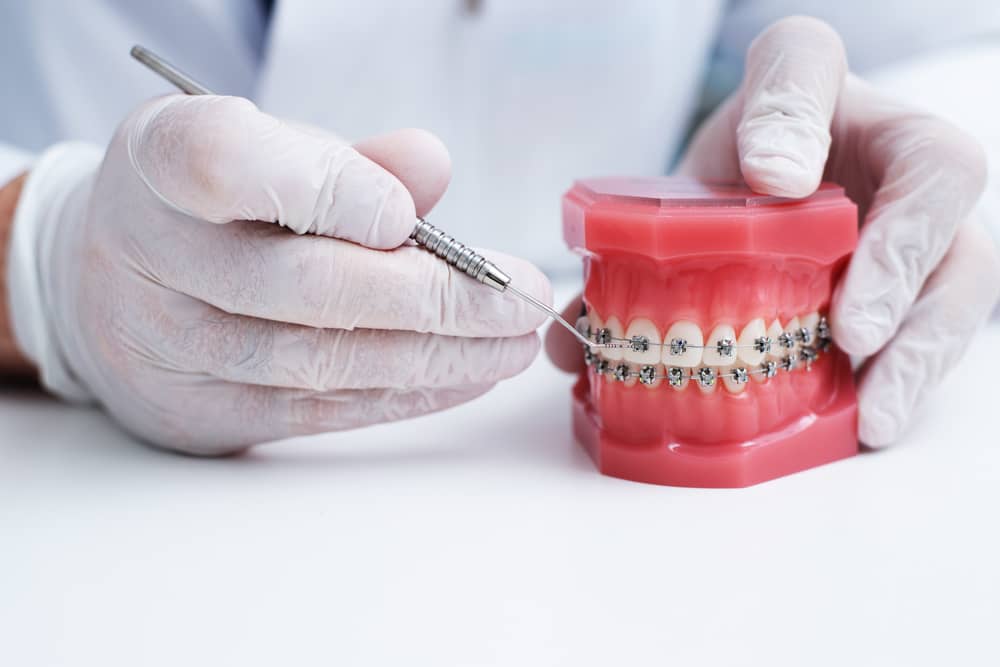Braces are likely the first thing that pops into your head when you think of ways to straighten your teeth. But how exactly does this set of metal wires, brackets, and bands move teeth into the right position in order to make a healthy smile?
Parts of Braces
Traditional braces are made up of a few different parts, which all work together to correct the position of your teeth. The brackets are small pieces of metal that create the base of the braces on each tooth. The brackets anchor the other parts of the braces to help guide your teeth into their correct positions. The archwire runs between each bracket to create the pressure needed to move the teeth into the right position, and elastic bands connect the archwire to the brackets to keep everything securely in place (except with self-ligating braces, which don’t require elastic bands).
Why Teeth Can Be Moved By Braces
So, how exactly do all of these parts move your teeth into the right position? The key to the way braces work lies in how the teeth are placed inside the jaw. Rather than actually being attached directly to the jaw bone, teeth are suspended in the jaw bone. Each tooth remains separated from the jaw bone by surrounding ligaments, which are layers of tissue similar in texture and density to stiff rubber. This provides each tooth a slight amount of give, which you can experience yourself by gently pressing on any of your teeth.
Each tooth has this layer of tissue surrounding it, which is surrounded by the jaw bone on every side. This structure is what allows baby teeth to come out and for adult teeth to erupt in their place, and it also makes orthodontic adjustments possible.
How Braces Move Teeth
As pressure is generated on a tooth, it starts to slowly compress against one side of the ligaments and jaw bone. This elastic compression starts to gradually eat away at the jaw bone on that side while the other side of the ligament experiences elastic expansion. To get back to an equilibrium of pressure, the body will naturally build more bone deposits on the other side of the tooth, surrounding it with a solid base that helps keep the tooth in its new position.
The actual structure of the braces, where the archwire connects to the brackets, creates points of leverage, which allows the archwire to generate pressure that pushes or pulls each tooth into its new position.
Can Braces Move Teeth Up and Down?
Typically, moving teeth up or down can be a bit more complicated than correcting other orthodontic issues. In the case of a long tooth, or a tooth that extends far beyond others, braces can be used to push the tooth further up in the gums to create a more even bite. If a tooth has the opposite issue, braces can be designed to pull the tooth further down. However, this can be delicate work because the gums around the affected area must be in good condition or else there could be a risk of receding gums. Typically braces need to put a certain amount of pressure on teeth to change their position. In order to move teeth up or down, less pressure should be added in that area to avoid causing root damage or inflaming the gums. For teeth that need to be moved up or down, you may notice that brackets and wires around those teeth may be positioned slightly differently or even feel different.
How Braces Move Teeth Forward
In some cases, braces may be needed to push teeth forward towards the lips in order to correct issues such as an underbite. Using an archwire with shape memory (think of it as something similar to a memory foam mattress) pulls the teeth forward. The wire is then bent to meet the bracket on the tooth, but with time the wire returns to its original U shape, carrying the tooth forward.
How Far Can Braces Move Teeth?
While it can depend on the severity of the misaligned teeth and the specific treatment plan crafted to correct the issue, braces are designed to move the average tooth about four millimeters. Moving teeth further than that may cause gum and jaw damage. However, there may be special cases if a tooth is severely misaligned where archwires may need to move teeth a little bit further. This is done with special care by your orthodontist to avoid damage.
Can Braces Move Teeth Too Fast?
While it may seem like this process takes forever, it’s intentionally drawn out for several reasons. For one thing, trying to make the process faster would cause a great deal of discomfort and could possibly even cause damage to your jaw and teeth. The slow process actually helps make the corrections possible. The gentle pressure allows for continued blood flow to the jaw and teeth, which is necessary for both overall health and for the bone deposits to form. However, if teeth are moving at too slow of a rate, it can be a sign to your orthodontist that something may not be right. This could mean the components of the braces aren’t adding enough pressure to actually move the teeth. Teeth will move at the rate that force is applied, and it’s a delicate balance to make sure teeth are moving in a way that doesn’t cause too much pain or is ineffective.
Why Orthodontic Treatment Takes So Long
Just like how Rome wasn’t built in a day, neither is your healthy smile. It can take some time to get things right and to go at a pace that makes sense for the orthodontic issues that need to be corrected without causing unnecessary damage or pain.
If you want to learn more about how different types of orthodontic treatments work and how you could benefit from them, contact Smith Orthodontics today to schedule your free consultation.
